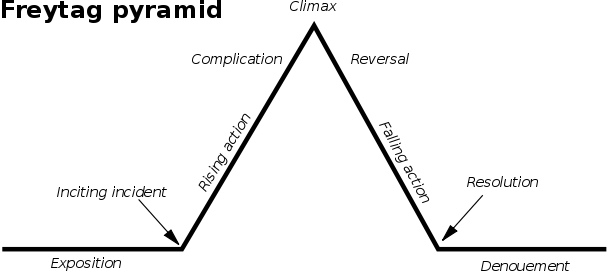
Think of some classic stories, e.g.
Star Wars
Harry Potter and the Philosopher's Stone
Jurassic Park
Rome and Juliet
Game of Thrones
Freytag Pyramid:
As a whole, the story you are think of probably conforms to this structure fairly closely. Why?
Do storytellers sometimes break this pattern?
Of course! In fact, many audiences expect deviation from the standard pattern, but that's only because they know it and sense when the story teller is deliberately exceeding its limits.
Also, stories are built out of mini stories (sequences or scenes) and these also may take the form of Fertag's pyramid. The closer you look at any story , the more you see it as a series of little rises and falls of tension.
How you you create suspense in a story?
Well, compare these two sequences.
Cinderella was a kind, beautiful and happy girl and her mum died and her father was lonely and remarried. Cinderella got a cruel stepmother and two ugly sisters. They were mean to her and she tried to be nice and they were still mean. Then her dad died and they were even meaner and made her do all the cleaning and Cinderella's life was hell. One day a letter came from the palace and they were all invited to the ball and they all dressed up and Cinderella was sad because she had no dress and couldn't go. They all went without her and she sat down and wept....
Cinderella was a kind, beautiful and happy girl. But then her mum died and her father was lonely. So he remarried. But Cinderella's stepmother was cruel and her stepsisters were also cruel and mean to poor Cinderella. But Cinderella still tried to be nice, but this just made them even meaner. So when Cinderella's dad died, the stepmother and stepsisters became even crueler and made poor Cinderella do all the housework. So Cinderella's life was hell. But one day a letter came from the palace inviting them all to a ball. So they all excitedly dressed up. Cinderella wanted to go to the ball too, but could not because she had nothing to wear and so she couldn't go. So off the others went. But Cinderella was left behind. So she sat down and wept.
Stories can be kept alive by contrast (buts) and consequence (sos).
The audience invests their interest or hopes in lines of action or character intentions that are almost guaranteed to be messed with, and consequently they become increasingly involved in the story.
2. Meanwhile
Another important thing about stories is plot weaving. Instead of thinking of a story as one single line of causation, think about it as a bunch of streams flowing down from the mountains. They start in different places but slowly they all meet up and converge into one river.
Many writers know exactly what this main climax is before they start writing. Many writers spend longer planning a story than executing it. A story that seems spontaneous probably only seems so because the writer planned it to seem so.
The word not to forget when planning a story is "meanwhile".
Work out one scenario to a point where people are going to want to know what's going to happen next. Then stop right there. Start another another scenario, the less obviously related the better. In the Cinderella example above, we could perhaps have stopped before the letter of invitation arrived and gone over, meanwhile, to the palace to learn more about why they have decided to organise the ball. When Cinderella finally meets the Prince and dances with him, it's like two streams meeting and forming a river.
'Meanwhile-ing' is one of the most fun parts of storytelling and you don't need to be a good writer - you just need good ideas. The audiences likes it when you drop a plot line, because they're looking forward to its return later.
Task:
1. Make a group of 3 people. Or a pair.
Start with this.
John lived alone with his pet parrot Harold. Janet lived alone with her pet monkey Harriet.
2. Meanwhile
Another important thing about stories is plot weaving. Instead of thinking of a story as one single line of causation, think about it as a bunch of streams flowing down from the mountains. They start in different places but slowly they all meet up and converge into one river.
Many writers know exactly what this main climax is before they start writing. Many writers spend longer planning a story than executing it. A story that seems spontaneous probably only seems so because the writer planned it to seem so.
The word not to forget when planning a story is "meanwhile".
Work out one scenario to a point where people are going to want to know what's going to happen next. Then stop right there. Start another another scenario, the less obviously related the better. In the Cinderella example above, we could perhaps have stopped before the letter of invitation arrived and gone over, meanwhile, to the palace to learn more about why they have decided to organise the ball. When Cinderella finally meets the Prince and dances with him, it's like two streams meeting and forming a river.
'Meanwhile-ing' is one of the most fun parts of storytelling and you don't need to be a good writer - you just need good ideas. The audiences likes it when you drop a plot line, because they're looking forward to its return later.
Task:
1. Make a group of 3 people. Or a pair.
Start with this.
John lived alone with his pet parrot Harold. Janet lived alone with her pet monkey Harriet.
At some point John and Janet are going to meet and fall in love.
Find an interesting way for this to happen.
Think about setting, time, context
problems, conflicts
way to develop character (motivations, backstory)
think about a subplot
No comments:
Post a Comment